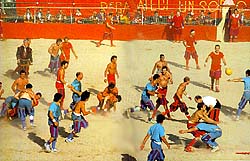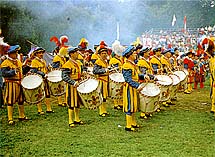
The traditional Football Game
The earliest information on the Football Game in period costume (or Traditional Football) being played in front of the Basilica of Santa Croce dates from the early 15th century, when the event was reserved for the younger members of the aristocracy; this sport had however already become extremely popular by the following century. Matches were held during the Carnival period, not only here but also in other areas of the city, like Via Il Prato, Piazza della Signoria or Piazza Santa Maria Novella. However matches were always held in Santa Croce during the important religious feasts, like that of St. John, the city's Patron Saint.
One of the most famous matches was held on February 17th 1530. Historian Benedetto Varchi tells us that in spite of the fact that the city was besieged by the armies of Charles V, who wanted to restore the Medici government, the population assembled in Piazza Santa Croce as usual to watch the traditional game. The match took place before the eyes and under the cannon-fire of the Imperial troups: a challenge that made the whole event become a demonstration of civic pride.
In 1580 Count Giovanni de' Bardi di Vernio wrote the first "Treatise" on Football, establishing the rules of the game which had 54 players, divided into two teams and "lined up in three rows, in ancient Roman battle formation". This tradition, interrupted in 1739 by the arrival of the Lorraine Grand Dukes, was started up again in 1930 as part of a campaign to promote tourism in Florence and organized by the Fascist government. The game was therefore enriched by a characteristic opening procession formed of almost 550 partecipants. This has remained unchanged: it is led by members of the aristocracy, announced by a presenter, and followed by the gonfaloniers of the four original city quarters (Santa Croce, San Giovanni, Santo Spirito and Santa Maria Novella), the representatives of the ancient corporations, flag wavers, mace-bearers, musicians, the master or the field (the referee) and last of all, the players, 27 in each team, all dressed in Renaissance costumes.

Historic
parade
The teams wear the colours of their quarters: blue for Santa Croce, green for San Giovanni, red for Santa Maria Novella, white for Santo Spirito. All three of the annual games are played in June in honour of St. John, the city's Patron Saint, whose feast is celebrated on June 24th. The prize is a calf.
The game is held in the centre of the square, which is covered in sand for the occasion, and reminds us more of rugby or American football than our modern version of the game. The rules, which have changed little since the 15th century, are practically non-existent: kicking, shouldering, elbowing, punching and blows below the belt, anything is allowed to enable the players to get hold of the ball and attempt a "caccia", in other words, to get the ball into the net of the adversary. Some shots are fired into the air with a culverin when a "caccia" is scored. The atmosphere is so explosive that brawls and broken noses abound, in spite of this the match is still well worth going to see.
